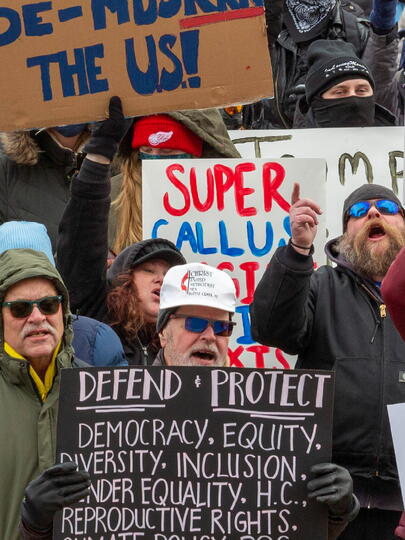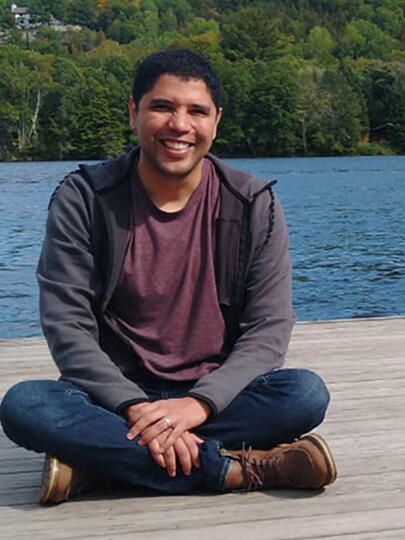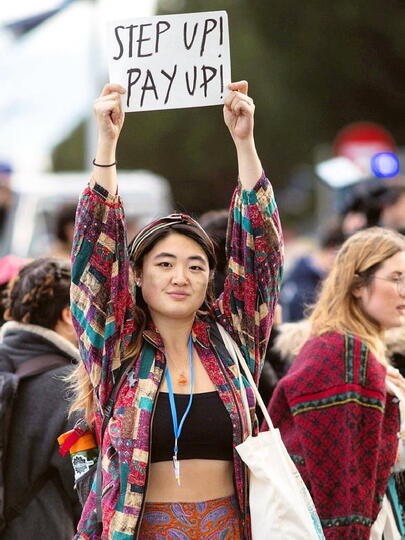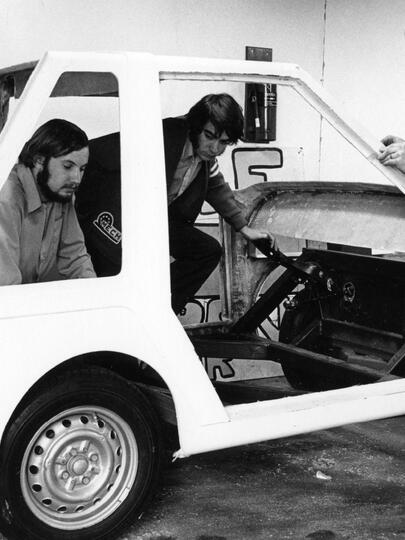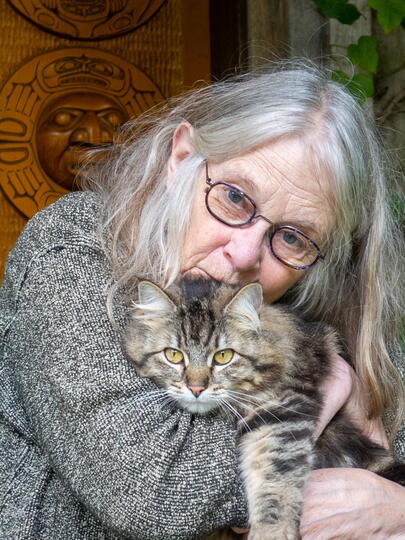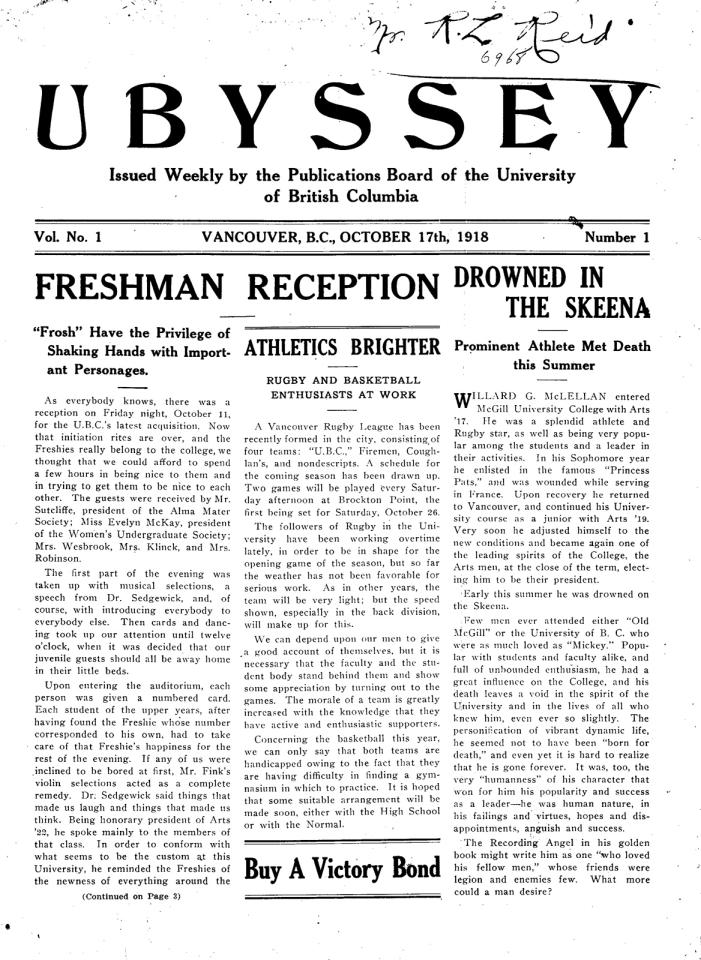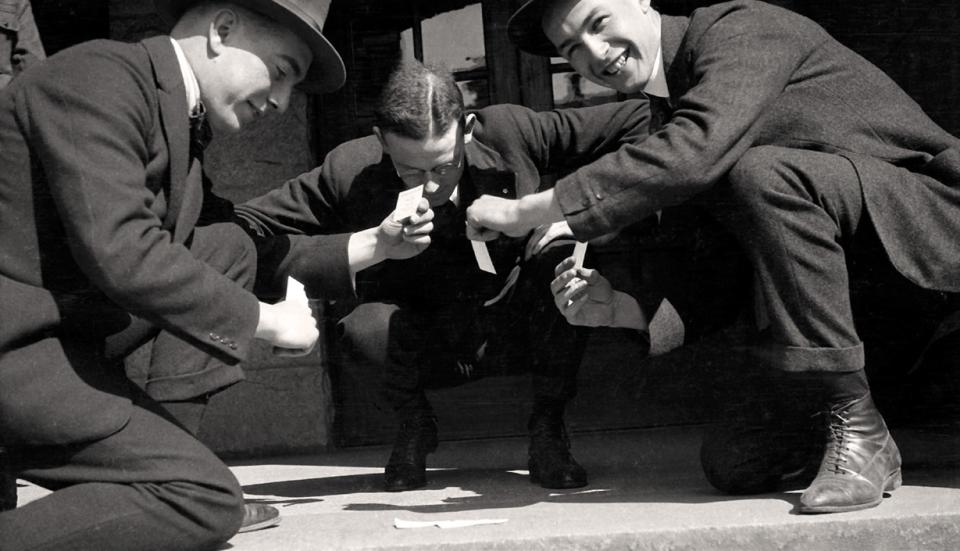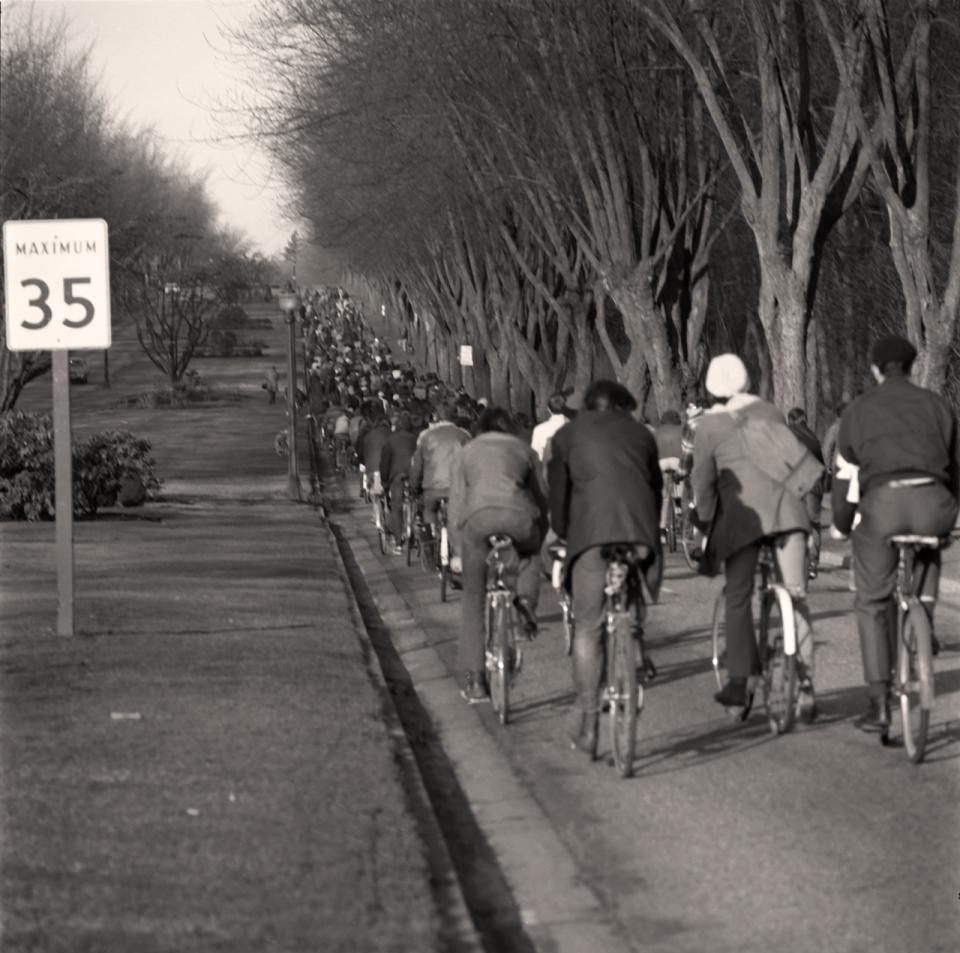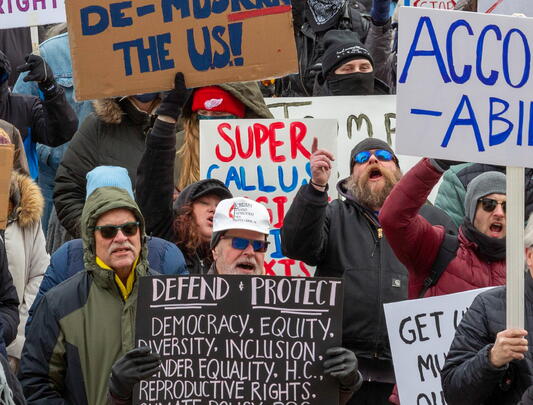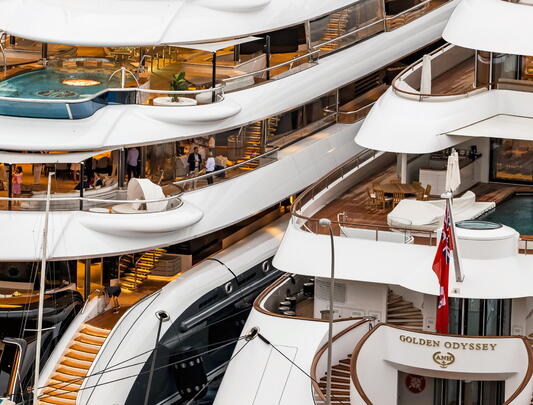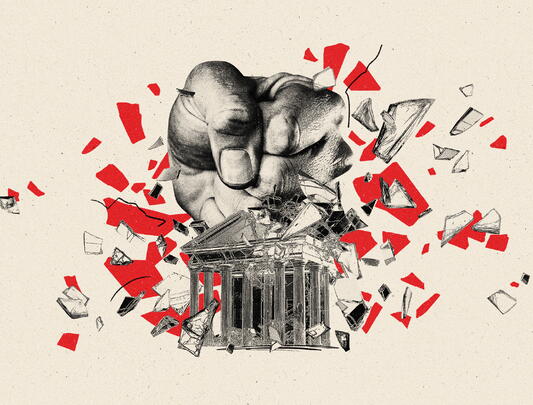
Great Trekking: A Hundred Years of Students at UBC
1915‑16
Year One: UBC opens. Classes begin on Thursday, September 30, 1915. Just over two weeks later, on Friday, October 15, the students gather in the Arts building on the original Fairview campus to create an association with the unusual name of Alma Mater Society. In the early years the Society is sometimes referred to as the Alma Mater, but later it becomes better known by its acronym (AMS), perhaps because Alma Mater made too many people think of the alumni: perhaps as well because no one was sure how to pronounce Mater.
1918‑19
War Is Over: But at a cost. Another 11 UBC students died, bringing the total to 78. And while the fighting wound down overseas, the worldwide influenza epidemic struck Vancouver: three more students died, and the University closed for five weeks. One final blow landed in October 1918: UBC President Wesbrook died after being ill for several months. Still, the Annual struck a celebratory note about the war, speaking of the pride that students could feel in having taken part in “the greatest crusade ever entered upon by men in the history of the world.”
Ubyssey: A new publication was born this year, a newspaper, the Ubyssey, a respelling and a reimagination of the old literary monthly, the Ubicee. Skits and poems are all very well, the new paper commented, but what is needed is news while it is still “hot,” by which the editors meant no more than a week old.
Naughty Oscar: The Players’ Club provoked controversy by staging a production of Oscar Wilde’s The Importance of Being Earnest. The Ubyssey expressed “disgust” at this “trash,” and said it would prefer something with “a healthy moral tone.”
1925‑26
Refreshments will be served: There was talk this year of establishing a Student Court to deal with discipline cases, and already in September the Ubyssey was registering the need for such a court by reporting on a “criminal” who was being charged with playing bridge for money, i.e., gambling in contravention of AMS Bylaws. Though the defendant said the charges were a violation of his individual rights, a trial was going ahead; however, since there was not yet a court, the case was to be heard by a joint meeting of the Men’s and Women’s Literary societies (!). Everyone was welcome to attend, said the Ubyssey, adding: “Refreshments will be served.”
A week later the defendant was acquitted by reason of “insanity”: the whole thing was treated as a bit of a joke, yet the push for a system of student‑run discipline continued, resulting in:
The Vigilance Committee: In November 1925 Council decided to create a secret body known as the Vigilance Committee, consisting of 10 men who would go undercover to try to catch smokers, loiterers, and other wrongdoers. The Ubyssey called the plan “obnoxious” and smacking of espionage. A general meeting of the students was called to vote on whether to abolish the new system, but voted in favour of keeping it. However, it was replaced the following year by the Honour System.
1931‑32
The Depression hits home: Barely mentioned in previous years, at the beginning of 1931‑32 the Depression was still someone else’s problem. In the fall the Women’s Undergraduate Society (WUS) launched a clothing drive for those affected by the recent economic difficulties. “We are making an endeavor to help the more unfortunate members of the community who have been harder hit by the depression than ourselves,” said the WUS President.
But by January it was the students themselves who felt hit. Rumours began to fly about cuts by the provincial government, which might result in the closure of certain departments (Agriculture, Nursing, and Commerce were mentioned). There was even talk that the University might shut down altogether.
They Do Things Differently Here: The visiting editor of the student newspaper at the University of Toronto was shocked to discover that at UBC the male and female students sat together in the cafeteria and the library. He also noted how different it was that the students at UBC were the ones raising the money for campus buildings and that there were no residences for students on campus (those wouldn’t come till much later). The students were younger too: admission age at UBC was 16.The students organized, launching a publicity campaign to enlist public support for the notion that the University was essential to the province. As in the days of the Great Trek, a petition was started (garnering 70,000 signatures), and there was large‑scale public support (from the Archbishop of Vancouver to the Trades and Labour Congress), but this time the government did not give in. Major cuts were made to the University budget, resulting in layoffs and a reduction in library hours. There was even a plan to merge Agriculture and Applied Science, which the Agriculture students objected to but which won support in some AMS quarters, causing internal division among the students. (The plan did not go ahead.)
1945‑46
Students to the left of them, students to the right of them: UBC had never seen so many students: 5,200 showed up in September, and another 1,200 (mostly ex‑servicemen) arrived in January. The Library was crowded, the buses were crowded, everything was crowded.
One of the downtown papers wrote a piece about the supposed division between the more mature returning servicemen and the younger “bobby‑soxers.” The Ubyssey ran an article deriding the idea, but felt compelled to revert to the topic more than once, so there may have been something to it.
Students to the left, students to the right (Part 2, political version): Sid Zlotnick of the left‑wing Labour‑Progressive Party (LPP) got in trouble with the Discipline Committee for distributing leaflets. No publications allowed unless approved by Student Council, the committee said. Zlotnick then lobbied to allow a Labour‑Progressive campus club to be formed. Council hesitated. We don’t have political clubs, they said, but let’s ask the Board of Governors. The Board said, This is a student matter; you decide. Grant Livingstone, a Conservative, said if the LPP can become a club, so should other political groups.
The Jokers! Founded in the fall with the slogan, “Come and make an ace of yourself,” the Jokers tried to liven up campus with their offbeat brand of humour. Members, all of whom were vice‑presidents of the club, walked around carrying yo‑yos. They organized goldfish swallowing contests to raise money for the new gym, along with a carnival, an egg auction in which students could buy eggs to hurl at one of the Jokers, and a roller‑skating marathon for which the slogan was: “Break a Limb! Support the Gym!”
Still uncertain what to do, Council decided to hold a plebiscite of the whole student body; this seems to have been the first one held on campus, and it resulted in a 2:1 vote against political clubs. Politics would have to wait for another day.
We are, we are, we are... the AUS? The Arts Undergraduate Society fell on hard times again, finding it difficult to get their members out to vote. The ever helpful Engineers sent 200 of their members to an Arts election meeting. Only 15 Arts students showed up, so the Engineers happily elected themselves to all the positions on the Arts executive. (Of course, this was all ruled out of order, but it did not bode well for the AUS.)
1953‑54
It also ran an article on excessive kissing in Brock Hall and suggested that the kissing booth at the annual Blood Drive was responsible for the record turnout of male blood donors.
A Sexy Year: The Kinsey Report on female sexuality came out this year, and UBC students engaged with it in a formal debate competition, in which victory went to the side arguing that the report was a threat to Western civilization (!). But if sex was defeated on this occasion, which is how the Ubyssey put it, nevertheless it seemed very much in the news, or at least in the Ubyssey. Sex is more important than religion, the paper said.
Apathy, Lethargy, and What is the AMS, anyway? Not for the first or last time, both Council and the Ubyssey complained about a lack of student interest in the running of the Society, noting the number of Council seats that were filled by acclamation. The Ubyssey also did a survey that revealed that some students didn’t know that being the AMS President meant being president of the student body.
Off with her head! Lots of Queens around this year: Homecoming Queen, Mardi Gras Queen, Frosh Queen: in fact, two rival Frosh Queens (almost). The Frosh Undergraduate Society protested when one of the fraternities announced that they were anointing the Frosh Queen. That’s just your Fraternity’s Queen, said the official Frosh; we’re going to choose our own. In the end, however, the official Frosh backed down, so no one ended up in the Tower, thankfully.
Perhaps the fault lay with the proliferation of mysterious acronyms, which had become so widespread that the Ubyssey ran an “alphabet soup” contest, asking students to identify as many acronyms as they could, from MAD, PhUS, and CUS to SCM, NFCUS, and the like.
1968‑69
But what’s it all about? The Ubyssey thought the occupation was an undeveloped expression of protest against oppression. Radicals, like the visiting Rubin himself, talked about rejecting traditional institutions, not accepting minor positions in the existing power structure, opposing corporate control of education and society, and revolutionizing society. Rubin also talked about having fun. “Free yourself,” he said. Also: “Wherever you see a rule, break it.”
It’s the Sixties, Man: Paris, Chicago, Berkeley... UBC? For a day at least, the day Jerry Rubin came to town. The leader of the Youth International Party (the Yippies), fresh from confrontations with police during the Chicago protests, showed up with his pig (a protest candidate in the 1968 US presidential election) and asked the students of UBC what they would like to liberate. “The Faculty Club,” someone called out, and 2,000 students invaded the professors’ inner sanctum, liberating not only the space but the contents of liquor cabinets and the club pond (skinny dipping!). Someone even brought a band.
In fact, the University was already experimenting with new approaches to teaching (introducing a new sort of inter‑disciplinary first year course called Arts One). It had also granted student representation on the University Senate, though radicals called the appointment of four student senators (out of 81) tokenism.
No, but what was it really about? Well, the occupation of the Faculty Club took place against a worldwide backdrop of student unrest, and at UBC itself the AMS had produced a brief calling for a variety of educational reforms to make courses more “relevant” and to give students a say in running the University. Demands were in the air: There should be students on governing bodies, the students should have a say in making appointments, something should be done about overcrowding. Some said, We should not have to attend dull and boring courses. Indeed.
And what good came of it? Well, the next day there was a giant rally (5,000 students) which called for a teach‑in on educational reform, and there was indeed a teach‑in the following week, endorsed by AMS President Dave Zirnhelt and UBC President Kenneth Hare. Zirnhelt, later an NDP cabinet minister, played a moderating role in the events, as did Hare, who seemed quite sympathetic to the students’ demands, so much so that even the radicals said nice things about him, though adding that of course he couldn’t really do anything because of the conservative power structure.
Hare eventually resigned just seven months after taking office (making him the shortest‑serving UBC president), and in response to AMS demands the committee to find a replacement for him included four students.
1970‑71
The Battle of Jericho: And lo the people of Jericho did refuse to move from their hostel until the army and the police force did forcibly remove them, pushing them out of the Jericho army base and onto Fourth Avenue, from whence they journeyed to the Student Union Building at UBC campus, where the students had said, “O ye homeless ones in need of shelter, you can rest here” – but then on second thought had said, No, sorry, you can’t.
But the people of Jericho, jobless youth with nowhere to go, did come anyway and occupied the SUB for 16 hours, staying overnight until the AMS Executive could find alternative lodging for them, while regular students grumbled that this was too much and the Ubyssey said it was not enough: it was time to stand up to the police state and oppression...
And that was the high point of militancy and activism for the year, a carryover from the Sixties perhaps, and occurring the same weekend in October that the FLQ crisis erupted in Quebec and Prime Minister Pierre Trudeau invoked the War Measures Act, prompting protests at UBC, but not too much, despite the best efforts of the Ubyssey.
Human Government: If activists had mixed results against evictions and the War Measures Act, they found more success at the ballot box, electing a new slate to all the positions on the AMS Executive. Steve Garrod’s Human Government group swept all before them, though not before the AMS had to rerun the presidential election because of irregularities. Garrod pledged Canadianization and democratization of the university, and also promised a referendum in October to let the student body pass judgement on his program, a promise he would live to regret.
Shades of Stan Persky: The Human Government slate drew inspiration from Stan Persky, the radical leader of the late Sixties who had almost become AMS President. (Perskyists, the Ubyssey called them.) Persky himself was still around and was even elected as a student Senator, though when he showed up for his first Senate meeting dressed up as an old man in a wheelchair, he was denied entrance.
Engineers Gone Wild: The Engineers reached new heights (or lows) this year, kidnapping a Ubyssey columnist and putting him through a mock crucifixion, kidnapping the Ombudsman and covering him in honey and feathers, trashing the Commerce students’ lounge and stealing their beer, vandalizing the Commerce students’ chariot, and causing the injury of a Forestry participant in the annual chariot race. Some even accused them of plotting to attack the SUB during the Jericho occupation to oust the occupiers, but that may have simply been their reputation at work. They did get into a fight with Maoists distributing literature in the SUB, and altogether their antics were so extreme that one group of Engineers, unhappy to be associated with such things, started a petition to withdraw from the Engineering Undergraduate Society.
New forms of activism: If the AMS and students at large seemed uninterested in the Ubyssey’s agenda, new causes were arising that would capture more support in subsequent decades. One was feminism: there was talk of starting a Women’s Studies program this year, and left‑wing labour leader Michel Chartrand found himself called out for being dismissive of women: it was the old activism giving way to the new.
Also this year saw a cyclists’ protest: about 400 of them disrupted traffic on University Boulevard to demonstrate in favour of bike paths. This protest even seemed to lead somewhere: within a month there was talk of improving cycling facilities on campus.
1983‑84
And they did: 33 per cent of them, and for good measure the government jumped in and cut student financial aid by 83 per cent and abolished all grants, leaving students free to accumulate debt.
The Cuts! The Cuts! Restraint, restraint, said the new Socred government, cutting back spending and taking away people’s rights. Solidarity, solidarity, said the people, forming coalitions, marching in rallies, going out on strike. We will join you, said the AMS of UBC, worried about funding cuts and the tuition increases that might follow.
And if you were a foreign student, good luck. For the first time in its history UBC began charging more to international students.
And there were petitions and marches, but the increases went ahead.
No good deed: And there were complaints that the AMS was becoming too much of a business, making too much money from such things as the Pit Pub and the Games Room. We’re supposed to be a non‑profit society, said a presidential candidate, and when General Manager Charles Redden was given a raise for his good work, the Ubyssey complained bitterly and published his salary for all to see.
Politics: That’s what the Ubyssey wanted the AMS to spend more time on: the Solidarity movement, of course, and also the campaign against military research. Some students petitioned successfully for a referendum calling for an end to such research, but it failed for lack of quorum. The Ubyssey took comfort in the fact that at least the majority of those who turned out to vote supported the anti‑military side, but in general it sighed about apathy and wished there was more politics and less business on campus.
The Other Solidarity: The provincial Solidarity campaign took its name from the Polish movement of the day, and to bring things full circle, another Solidarity group sprang up on campus to protest the bringing to UBC of a Polish professor known for his connections to the pro‑Soviet military government. Led by Bill Tieleman, later a Vancouver political analyst, Campus Solidarity picketed outside the visiting professor’s classroom, prompting debate about free speech and academic freedom.
1997‑98
Here’s Pepper in Your Eye: And the world’s leaders came to UBC to discuss free trade, and the students protested, and the police sprayed them with pepper spray. And Nardwuar the Human Serviette (from CiTR student radio) asked Jean Chrétien what he thought about it all, and the Prime Minister said pepper was just something he put on his plate. And the press went wild. Such was APEC (Asia‑Pacific Economic Cooperation) in Vancouver in November 1997.
The Gagged Goddess: Even before November the students were protesting and for some reason vandalizing the Goddess of Democracy. At one point she was gagged with a label saying Coca‑Cola, suggesting that the point was to attack what some saw as excessive corporatization of the campus. Not only was the Coke deal still in force [in the 1995-96 year, the AMS had joined the University in a ten-year exclusivity agreement with Coca-Cola], but there was talk of both the university and the AMS entering into other exclusivity deals. This sort of thing led to one graffiti artist putting up slogans on the new Koerner Library.
Feminist Triumphs? Meanwhile the AMS Executive achieved a high point of female power this year: four of the five Executives were women. And in the presidential election for 1998‑99, the two serious candidates were both women: Vivian Hoffman, the outgoing Director of Finance, bested the Coordinator of External Affairs, Shirin Foroutan, to become the new president.
Kinder, gentler Engineers: The president of the Engineering Undergraduate Society vowed that the Engineers would henceforth be less rowdy and boisterous. Less drinking, fewer dunkings in the library pool. But still stunts: this year they performed their signature stunt of hoisting a Volkswagen Beetle on high, in this case on top of Rogers Arena (then known as GM Place).
They also stole the Great Trekker trophy and returned it with a new inscription, honouring that greatest of Great Trekkers: James T. Kirk.
2001‑02
And the Pall of 9/11 Hangs Over It All: At least it did for a while. The attack on the World Trade Center captured the attention of the campus. There was a memorial service led by UBC President Martha Piper. The AMS started a blood drive and raised donations for the Red Cross. And when the Americans responded by entering Afghanistan some students countered with protests and “die‑ins.” But eventually life moved on.
Bye‑bye Freeze: The big news post‑9/11 was the end of the tuition freeze, lifted by the new Liberal government of Gordon Campbell. UBC responded by saying it would raise tuition to match the national average. Why, said the AMS, wondering about the relevance of tuition levels in Ontario. Show us what you’re going to spend the money on, and make sure some of it is on financial aid and other student services. The University did back down from its objective of matching the national average and did begin producing booklets showing where the money would go, but fees did rise.
Protests! While the AMS leadership made presentations to the Board of Governors, some students decided more radical action was needed, marching on campus, occupying the Administration Building, and even invading the Executive corridor at the SUB to criticize newly elected AMS President Kristen Harvey. Harvey said the protesters, who were calling not just for a continuation of the freeze but for a reduction in tuition, did not represent majority opinion on campus. They certainly did not represent the majority view on AMS Council, which defeated a motion to support the reduce tuition campaign; some Councillors said that the tuition freeze, coupled with government cutbacks, had jeopardized the quality of education at UBC and increases were needed.
Klahowya: Speaking of Kristen Harvey, her election meant that for the first time the AMS had an aboriginal president. It was a far cry from the days when UBC students appropriated aboriginal themes without being aboriginal themselves.
2014‑15
The Nest! The Nest! Finally, after years of planning and negotiating, delays in construction, and the appearance of Gus the Seagull as mascot, the New SUB, aka the AMS Student Nest, opened. The AMS moved from the suddenly shabby looking Old SUB to the spectacular new building next door, which quite dwarfed the Old SUB and everything else in the area.
Great Trekking will be available spring 2016. Details on purchasing copies will be posted on the AMS website (ams.ubc.ca). For more information, please contact AMS Archivist Sheldon Goldfarb at archives@ams.ubc.ca.
